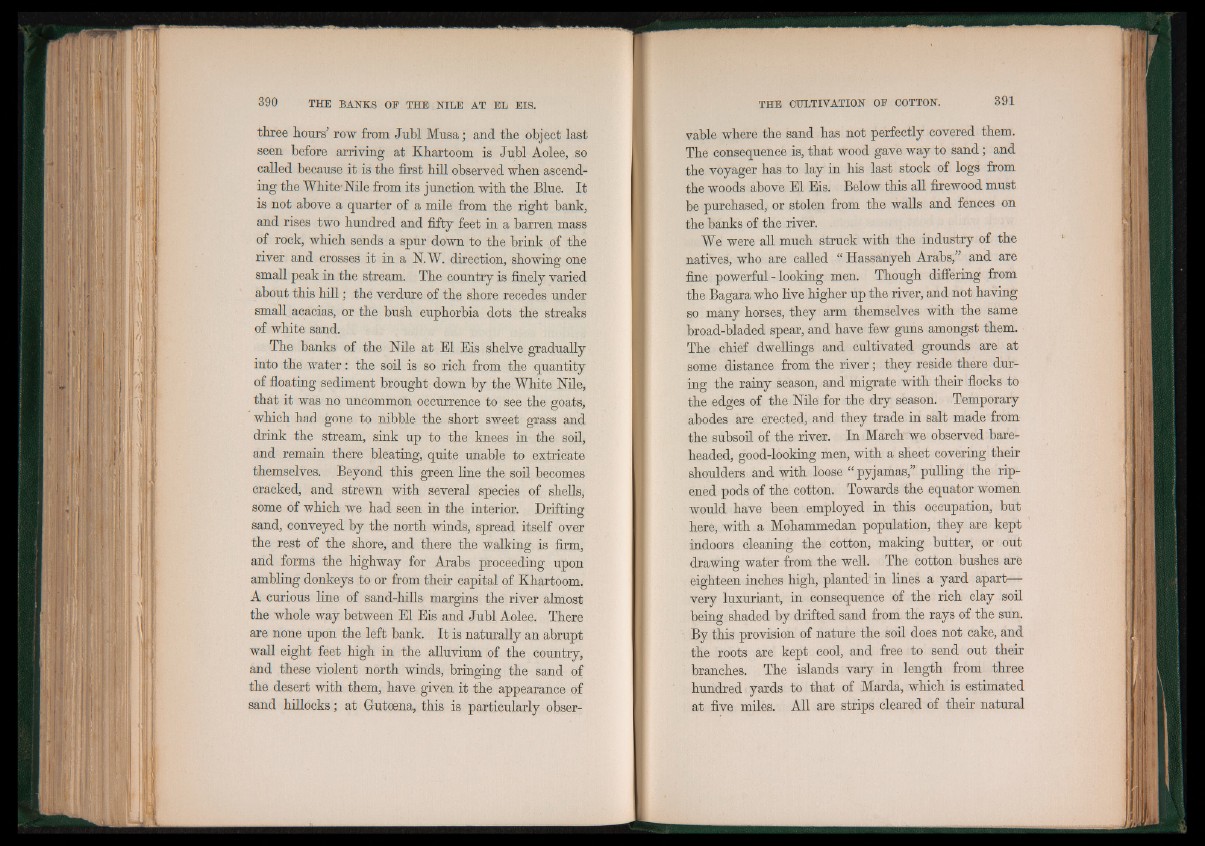
three hours’ row from Jubl Musa; and the object last
seen before arriving at Khartoom is Jubl Aolee, so
called because it is the first hill observed when ascending
the White'Nile from its junction with the Blue. It
is not above a quarter of a mile from the right bank,
and rises two hundred and fifty feet in a barren mass
of rock, which sends a spur down to the brink of the
river and crosses it in a N.W. direction, showing one
small peak in the stream. The country is finely varied
about this hill ; the verdure of the shore recedes under
small acacias, or the bush euphorbia dots the streaks
of white sand.
The banks of the Nile at El Eis shelve gradually
into the water: the soil is so rich from the quantity
of floating sediment brought down by the White Nile,
that it was no uncommon occurrence to see the goats,
which had gone to nibble the short sweet grass and
drink the stream, sink up to the knees in the soil,
and remain there bleating, quite unable to extricate
themselves. Beyond this green line the soil becomes
cracked, and strewn with several species of shells,
some of which we had seen in the interior. Drifting
sand, conveyed by the north winds, spread itself over
the rest of the shore, and there the walking is firm,
and forms the highway for Arabs proceeding upon
ambling donkeys to or from their capital of Khartoom.
A cunous line of sand-hills margins the river almost
the whole way between El Eis and Jubl Aolee. There
are none upon the left bank. It is naturally an abrupt
wall eight feet high in the alluvium of the country,
and these violent north winds, bringing the sand of
the desert with them, have given it the appearance of
sand hillocks; at Gutoena, this is particularly observable
where the sand has not perfectly covered them.
The consequence is, that wood gave way to sand; and
the voyager has to lay in his last stock of logs from
the woods above El Eis. Below this all firewood must
be purchased, or stolen from the walls and fences on
the banks of the river.
We were all much struck with the industry of the
natives, who are called “ Hassanyeh Arabs,” and are
fine powerful - looking men. Though differing from
the Bagara who live higher up the river, and not having
so many horses, they arm themselves with the same
broad-bladed spear, and have few guns amongst them.
The chief dwellings and cultivated grounds are at
some distance from the river; they reside there during
the rainy season, and migrate with their flocks to
the edges of the Nile for the dry season. Temporary
abodes are erected, and they trade in salt made from
the subsoil of the river. In March we observed bareheaded,
good-looking men, with a sheet covering their
shoulders and with loose “ pyjamas,” pulling the ripened
pods of the cotton. Towards the equator women
would have been employed in this occupation, but
here, with a Mohammedan population, they are kept
indoors cleaning the cotton, making butter, or out
drawing water from the well. The cotton bushes are
eighteen inches high, planted in lines a yard apart—
very luxuriant, in consequence of the rich clay soil
being shaded by drifted sand from the rays of the sun.
By this provision of nature the soil does not cake, and
the roots are kept cool, and free to send out their
branches. The islands vary in length from three
hundred yards to that of Marda, which is estimated
at five miles. All are strips cleared of their natural